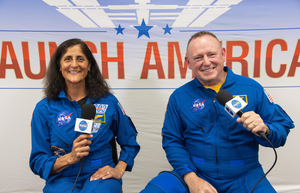America
Launch of Sunita Williams' piloted Starliner to space delayed until June, according to NASA.

May 23 in Washington, DC:
Sunita Williams, an Indian national, will be piloting Boeing's Starliner spacecraft on its maiden voyage to the International Space Station (ISS) on June 1, according to a Thursday announcement by the US space agency NASA.
The space agency announced that mission managers from NASA, Boeing, and ULA (United Launch Alliance) are still working on a plan to send the Boeing Crew Flight Test (CFT) to the International Space Station (ISS).
There will be additional launch opportunities on June 2, June 5, and June 6, and the teams are currently aiming for 12:25 p.m. ET on June 1st. The first human-carrying journey to space on the Starliner had been postponed multiple times due to a helium leak in the spacecraft's service module; the original launch date had been May 7.
Sunita Williams and fellow NASA astronaut Barry "Butch" Wilmore will be travelling to the International Space Station on Boeing's Staliner spacecraft for a last test run before the US space agency can authorise the Starliner for regular trips to and from the ISS.
United Launch Alliance's (ULA) Atlas 5 rocket will launch the Starliner spacecraft into orbit from Florida's Cape Canaveral Space Force Station. After spending around two weeks at the orbiting lab, the pair will return to Earth in the West Coast of the United States to assess the new spacecraft and its equipment.
The joint teams from NASA, Boeing, and ULA have been working tirelessly for the past two weeks to fix the Starliner Service Module helium manifold leak and replace the Centaur Self Regulating Valve, according to Steve Stich, manager of the NASA Commercial Crew Programme.
A statement was released by the US space agency, stating that the agency had carefully considered all the issues, including the Starliner propulsion system's redundant capabilities and any potential consequences for its Interim Human Rating Certification.
"We will launch Butch and Suni on this test mission after the entire community has reviewed the teams' progress and flight rationale at the upcoming Delta Agency Flight Test Readiness Review," according to him.
The crew that is still quarantined will return to NASA's Kennedy Space Centre in Florida closer to the revised launch date, while Sunita Williams and Barry Wilmore keep rehearsing in Starliner simulators, according to the space agency.
A valve malfunction in the upper stage of the Atlas 5 rocket caused mission managers of the Crewed Test Flight (CFT) of the Boeing Starliner to cancel the flight on May 7, only two hours before liftoff. The valve was changed and checked on May 11 to ensure it was functioning correctly, according to Boeing's statement.
A "small helium leak" in the spacecraft's service module caused the postponement of the CFT mission from May 17 to May 21, according to NASA's announcement later on May 14.
The launch was further delayed to May 25, according to the space agency's announcement on May 17.
This mission, the first human-manned Starliner trip by Boeing, is a component of the Commercial Crew Programme, a public-private cooperation between the National Aeronautics and Space Administration (NASA) and the United States aerospace industry aimed at launching humans from the United States aboard American rockets and spacecraft.
U.S. crew transportation to the International Space Station was awarded to Boeing and SpaceX in September 2014 by NASA. For NASA missions, these interconnected spacecraft, rockets, and related equipment can accommodate up to four humans, allowing for a crew of seven on the space station to make the most of the time spent conducting scientific research there.
Boeing successfully completed the unmanned Orbital Flight Test 2 (OFT-2) in 2022 following a failed attempt in December 2019. In six months, the aerospace business claims that the Starliner will be ready for ten missions of reuse. Since its maiden voyage on May 30, 2020, the Crew Dragon, owned by Elon Musk's SpaceX, has completed twelve crewed trips. The United States government allocated over $4 billion to Boeing for the Starliner's development, while SpaceX received approximately $2.6 billion.



































